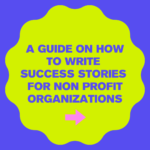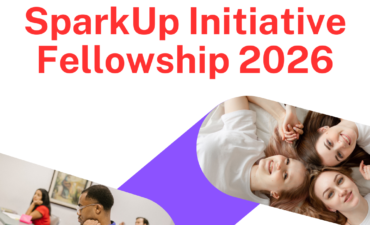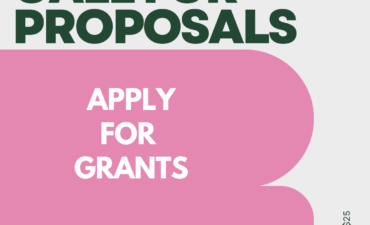Introduction: A Short Guide on How to Write Success Stories for Non Profit Organizations, to begin with success stories stand as powerful testaments to the impact and effectiveness of an organization’s initiatives. These narratives go beyond mere documentation; they encapsulate the essence of an NPO’s mission, illustrating real-world change and tangible outcomes. Success stories serve as compelling tools that not only showcase an organization’s dedication to its cause but also provide a means to connect with stakeholders on a profound and emotional level.
There could be a number of reasons why a Non Profit Organization should showcase their testimonials in a written text which are so called success stories, these stories contributes towards the trust factor of the Non Profit Organizations.
A Short Guide on How to Write Success Stories for Non Profit Organizations
Here are some more reasons why NGOs should look forward to collect field testimonials and convert them into written success stories.
- Elevating Visibility and Credibility:
- Success stories act as beacons, illuminating the meaningful work undertaken by NPOs. They contribute to heightened visibility in the public eye and establish credibility within the philanthropic and grant-making community.
- Inspiring Stakeholders and Supporters:
- These stories have the power to inspire and mobilize various stakeholders, including donors, volunteers, and community members. By narrating the journey from challenge to triumph, success stories cultivate a shared sense of purpose and foster a deeper connection with the organization.
- Demonstrating Impact and Accountability:
- Success stories provide a tangible demonstration of an NPO’s impact on the ground. Through clear and compelling narratives, organizations can communicate the positive change they bring about, reinforcing their commitment to accountability and transparency.
- Facilitating Knowledge Sharing:
- By sharing successes, NPOs contribute to a collective knowledge base within the sector. These stories become valuable resources for other organizations seeking effective strategies, ultimately fostering collaboration and mutual learning.
- Strategic Communication for Fundraising:
- In the realm of international grants, success stories become invaluable assets for fundraising efforts. They not only showcase the organization’s capabilities but also align with the storytelling strategies that resonate with grantors and funding agencies. A Short Guide on How to Write Success Stories for Non Profit Organizations
Winning International Grants comes as a dream come true for many grass root NGOs, when the success story of an organization is place strategically backed with data, evaluation reports and recorded testimonials.
In the realm of non-profit organizations (NPOs), securing international grants is often contingent upon more than just a compelling mission or a track record of initiatives. Funders and grantors increasingly recognize the power of effective storytelling as a critical element in the grant application process. This guide aims to equip NPOs with the knowledge and tools necessary to harness the potential of storytelling, not only to articulate their impact but to strategically position themselves for success in the competitive landscape of international grants.
- Strategic Positioning:
- The guide will elucidate how storytelling serves as a strategic tool for positioning an NPO within the context of international grant applications. By crafting narratives that resonate with the priorities and values of potential grantors, organizations can strategically align their stories with the broader goals of the funding entities.
- Building Emotional Connections:
- Emphasizing the emotional resonance of storytelling, the guide will demonstrate how NPOs can go beyond facts and figures to create narratives that forge genuine connections with grantors. Understanding the human side of impact can be a compelling factor in securing support for global initiatives. A Short Guide on How to Write Success Stories for Non Profit Organizations
- Demonstrating Impact Clearly and Convincingly:
- One of the primary purposes of this guide is to help NPOs articulate their impact in a way that is not only clear and concise but also emotionally resonant. By presenting success stories in a compelling manner, organizations can effectively convey the tangible difference they make on a global scale.
- Navigating Diverse Grant Application Requirements:
- International grant applications vary widely in their requirements and preferences. This guide will provide insights into tailoring success stories to suit the specific criteria of different grantors, ensuring that NPOs can adapt their narratives to various funding opportunities.
- Enhancing Competitiveness:
- Acknowledging the competitive nature of international grants, the guide will offer strategies for NPOs to differentiate themselves through storytelling. Crafting narratives that captivate and leave a lasting impression is essential for standing out among a sea of applications. A Short Guide on How to Write Success Stories for Non Profit Organizations
- Maximizing Online Presence for Grant Success:
- With an increasing emphasis on online platforms for grant applications and reviews, the guide will explore how NPOs can leverage their online presence through success stories. This includes utilizing websites and social media to effectively communicate their mission and impact.
- Empowering NPOs for Sustainable Funding:
- Ultimately, the overarching purpose of this guide is to empower non-profit organizations with the knowledge and skills needed to secure sustainable funding through international grants. By mastering the art of effective storytelling, NPOs can create a lasting impact and garner the financial support required to drive meaningful change on a global scale.
The purpose of writing an emotionally compelling success story should be identified first, that also because there will be many other organizations bidding for the same project in your geographical area so you need to stand out, your stories should have depth that solves the purpose of interventions as intended in the proposal.
Identify the Target Audience for Success Stories
- Grantors and Funding Agencies:
- The primary audience for success stories includes international grantors and funding agencies. Tailoring narratives to resonate with the priorities and values of these entities is crucial for capturing their attention and support.
- Donors and Philanthropic Organizations:
- Donors, both individual and institutional, are a key audience. Crafting stories that appeal to their philanthropic ideals and showcase the tangible impact of contributions can enhance donor engagement and support.
- Government Bodies and NGOs:
- Success stories can also serve as a means of collaboration and knowledge exchange among governmental bodies and other non-governmental organizations. Sharing experiences and best practices can foster partnerships and cooperation.
- General Public and Advocacy Groups:
- Beyond the immediate stakeholders in the grant application process, success stories can resonate with the general public and advocacy groups. Engaging a broader audience can raise awareness, generate public support, and contribute to the broader mission of the NPO.
Clarify the Purpose of Writing Success Stories for International Grants
- Evidencing Impact:
- The primary purpose is to provide tangible evidence of the NPO’s impact on the ground. Success stories serve as a bridge between the organization’s mission and the real-world change it brings about, offering concrete examples of positive outcomes.
- Establishing Credibility:
- Success stories play a crucial role in establishing and reinforcing the credibility of the NPO. By showcasing past successes, the organization demonstrate its capacity to effectively implement projects and deliver on its mission.
- Aligning with Grantor Priorities:
- Writing success stories with international grants in mind involves aligning narratives with the specific priorities and criteria of potential grantors. Clearly illustrating how the NPO’s work corresponds to the goals and values of the funding entity enhances the likelihood of successful grant applications. A Short Guide on How to Write Success Stories for Non Profit Organizations
- Inspiring Confidence and Trust:
- Success stories are a powerful tool for inspiring confidence and trust in the NPO. By transparently communicating achievements, challenges, and lessons learned, organizations can demonstrate their commitment to accountability and responsible stewardship of funds.
- Differentiating from Competitors:
- In the competitive landscape of international grants, success stories serve to differentiate the NPO from competitors. Crafting narratives that are compelling and unique helps the organization stand out and leave a lasting impression on grantors.
- Creating a Compelling Narrative:
- Beyond meeting specific grant requirements, success stories contribute to the creation of a compelling narrative for the NPO. This narrative, when well-crafted, has the potential to evoke emotions, build connections, and make a lasting impact on the minds of those reviewing grant applications.
- Facilitating Communication and Collaboration:
- Success stories are a means of communication, not only with potential funders but also with other organizations, stakeholders, and the wider community. They facilitate collaboration, knowledge sharing, and contribute to the collective efforts of the non-profit sector.
Understanding the diverse audience and purpose behind success stories is foundational for NPOs seeking to effectively leverage storytelling in their pursuit of international grants.
A Short Guide on How to Write Success Stories for Non Profit Organizations
Let us now discuss the Key Components of a Success Story
- Hooking the Reader with a Compelling Opening:
The opening of a success story is the gateway to capturing the reader’s attention. Employ a captivating anecdote, a thought-provoking quote, or a vivid description that draws the reader into the narrative. This initial hook should create intrigue and set the stage for the compelling journey ahead.
Example: In the heart of a bustling community, where hope flickered like a fragile flame, one non-profit organization dared to dream of transformation. Picture a dusty street, children playing with newfound joy — this is the canvas on which our story of impact unfolds.
- Clearly Stating the Mission and Objectives of the NPO:
Immediately follow the hook with a clear and concise statement of the NPO’s mission and objectives. This sets the context for the reader, providing a foundation for understanding the organization’s overarching goals and the specific focus of the success story.
Example: At XYZ Foundation, our mission is to empower marginalized communities through sustainable education initiatives. Our objective is to break the cycle of poverty by providing access to quality education, ensuring that every child has the opportunity to flourish and reach their full potential
This introduction lays the groundwork for the success story, combining an engaging start with a clear presentation of the NPO’s mission and objectives, establishing the purpose of the narrative that follows.
- Visual elements play a pivotal role in bringing a success story to life
Visual elements bring in depth and resonance to the narrative. When incorporating photos, info graphics, and other visuals, it’s essential to ensure they not only capture attention but also work harmoniously with the storytelling, creating a compelling and immersive experience for the audience.
Integrate visuals strategically throughout the success story, aligning them with key points in the narrative. Whether it’s an impactful photo capturing a moment of change or an info graphic illustrating project milestones, place visuals where they naturally enhance the understanding of the text.
- Providing Context for the Project or Initiative:
In the vibrant urban fabric of [City], our NPO embarked on a transformative initiative known as “Green Harbor.” The genesis of this project lies in our deep-rooted commitment to environmental sustainability and community well-being. Nestled along the banks of the [River], the Green Harbor initiative aimed to rejuvenate and preserve the delicate ecosystem of this waterway while fostering a sense of environmental responsibility among the local populace.
The idea took shape as a response to the increasing ecological degradation witnessed in the region. Rapid urbanization, industrial runoff, and a burgeoning population were placing immense pressure on the delicate balance of the [River] ecosystem. The once-pristine waters were grappling with pollution, affecting not only aquatic life but also posing significant threats to the health and livelihoods of the communities dependent on the river. A Short Guide on How to Write Success Stories for Non Profit Organizations
- Describing the Challenges or Issues Addressed by the NPO:
Green Harbor was conceived against the backdrop of multifaceted challenges that demanded immediate attention. The [River], once served as a lifeline for the community, faced pollution from industrial discharges, improper waste disposal, and the unchecked growth of invasive species.
These challenges not only jeopardized the river’s biodiversity but also posed health risks to those relying on it for drinking water and livelihoods.
Moreover, the communities along the riverbanks, often marginalized and lacking access to education, were grappling with the environmental fallout while being unaware of sustainable practices. The challenge extended beyond ecological concerns to encompass the need for community engagement and empowerment, making the Green Harbor initiative a holistic response to environmental and social issues.
Through this background, it becomes evident that Green Harbor was not merely a conservation effort; it was a nuanced response to a confluence of environmental and social challenges, embodying the NPO’s dedication to fostering sustainability and empowering communities.
A Short Guide on How to Write Success Stories for Non Profit Organizations
Your success stories and field testimonials should reflect a non reversal trend and transformation that can sustain itself over long period of time. Even when way back the intervention has backed out.
Sustainability is the key word; reflection of same is appreciated if not necessary.
- Outlining the Long-Term Effects and Sustainability of the Project:
The success of any project extends beyond immediate outcomes; it hinges on its capacity to instigate lasting change and foster sustainability. In this section, we delve into the enduring impact of the NPO’s project and its commitment to a sustainable future.
- Holistic Impact Assessment:
Explore the multifaceted impacts of the project on the community, environment, and overall socio-economic dynamics. Examine how the initiative has not only addressed immediate challenges but also laid the groundwork for sustained positive change.
- Economic Empowerment and Self-Sufficiency:
Highlight how the project contributes to the economic empowerment of the community, creating avenues for self-sufficiency. Whether through skill development, entrepreneurship opportunities, or employment generation, emphasize the pathways to long-term financial stability.
- Environmental Stewardship:
Articulate the project’s contribution to environmental sustainability. Showcase initiatives that promote biodiversity, reduce ecological footprint, and ensure the responsible use of natural resources. This could include reforestation efforts, waste management systems, or renewable energy projects.
- Demonstrating the NPO’s Commitment to Lasting Change:
Sustainable impact requires an unwavering commitment to continuous improvement and adaptation. Illustrate how the NPO goes beyond short-term interventions, emphasizing its dedication to fostering lasting change.
- Community Engagement and Ownership:
Showcase how the NPO actively involves the community in decision-making processes and project implementation. Highlight community-led initiatives and the cultivation of a sense of ownership, as these are indicators of sustainability.
- Capacity Building and Education:
Detail the NPO’s efforts in building the capacity of community members. This includes educational programs, training sessions, and initiatives that empower individuals with the knowledge and skills needed to sustain positive change.
- Monitoring and Evaluation Strategies:
Discuss the NPO’s robust monitoring and evaluation mechanisms. Demonstrate how the organization systematically tracks project outcomes, collects feedback, and uses data-driven insights to adapt strategies for greater effectiveness over time.
- Partnerships and Collaboration:
Highlight collaborations with local stakeholders, government bodies, and other organizations. Illustrate how these partnerships contribute to the sustainability of the project by leveraging shared resources, expertise, and a collective commitment to long-term impact.
- Adaptability to Changing Contexts:
Emphasize the NPO’s adaptability to changing circumstances. Discuss how the organization anticipates and responds to evolving community needs, economic shifts, and environmental challenges, ensuring that the project remains relevant and effective in the long run.
By elucidating the long-term effects of the project and demonstrating the NPO’s commitment to lasting change, this section reinforces the organization’s dedication to creating a positive, sustainable impact that extends far into the future.
Look at the big picture, as Non Profit Organization, your goal is to get yourself recognized at a global level, it’s not about winning grants always, but the world should know how much you care for the cause you work for.
- Mapping to Grantor Priorities:
- Clearly articulate how the NPO’s projects align with the priorities and objectives of international grantors. Identify key themes and focus areas of the grantors, and showcase how the NPO’s work directly contributes to these priorities.
- Global Impact Metrics:
- Provide global impact metrics to underscore the significance of the NPO’s work. Use quantifiable data and success indicators that resonate with international grantors, showcasing the scalability and replicability of the organization’s solutions.
- Cross-Border Collaboration:
- Highlight instances of cross-border collaboration and partnerships that the NPO has forged. Illustrate how such collaborations contribute to a broader, international effort to address shared challenges and achieve collective goals.
- Contributing to Global Solutions:
- Position the NPO’s initiatives as not only addressing local issues but also contributing to the development of global solutions. Emphasize the organization’s role in knowledge sharing, best practices, and its potential to inspire similar initiatives globally.
- Advancing Global Citizenship:
- Showcase how the NPO’s work fosters a sense of global citizenship within the community it serves. Illustrate initiatives that promote cultural exchange, understanding, and collaboration, aligning with the broader objectives of international grantors.
- Alignment with Global Trends:
- Demonstrate how the NPO’s projects align with current global trends and priorities. Whether it’s addressing the impacts of a global crisis or contributing to emerging solutions, underscore the organization’s relevance in the context of broader international discourse.
By effectively identifying global issues addressed by the NPO and emphasizing alignment with international grant objectives, this section reinforces the organization’s relevance on the global stage and enhances its appeal to potential international grantors.
A Short Guide on How to Write Success Stories for Non Profit Organizations
Last but not the least here some quick tips on Dos and Don’ts on writing the success stories or testimonials.
Dos:
- Be Authentic and Transparent:
- Authenticity is the cornerstone of effective storytelling. Be genuine in conveying the challenges faced, the lessons learned, and the impact achieved. Transparency builds trust with your audience, including potential grantors, fostering a deeper connection.
- Focus on Measurable Outcomes:
- Emphasize concrete and measurable outcomes of your NPO’s initiatives. Use data, statistics, and tangible examples to illustrate the real-world impact of your projects. This not only strengthens your credibility but also provides a clear understanding of the results achieved.
- Tailor Stories to the Target Grantor’s Priorities:
- Customize your success stories to align with the priorities and values of the specific grantor or funding agency. Demonstrate a clear understanding of their objectives and showcase how your NPO’s work directly contributes to their mission, increasing the likelihood of grant success.
Don’ts:
- Exaggerate or Misrepresent Impact:
- Resist the temptation to exaggerate or misrepresent the impact of your projects. Stick to accurate and verifiable information. Grantors value honesty and overstating achievements can erode trust and credibility, potentially harming your organization’s reputation.
- Use Overly Technical Language that May Alienate Readers:
- Avoid jargon or overly technical language that might alienate your audience, including grantors who may not have specialized knowledge in your field. Strive for clear, accessible language that allows a diverse audience to understand and appreciate the significance of your work.
These Dos and Don’ts provide guidance for crafting success stories that are not only compelling but also align with ethical standards, ensuring that your NPO effectively communicates its impact while maintaining integrity and credibility.
On a closing note, from the importance of authentic narratives to the strategic use of visuals, we’ve explored how to captivate audiences by providing context, addressing challenges, and showcasing sustained impact. Emphasizing the global relevance of an NPO’s work and aligning stories with grantor priorities have been underscored as crucial strategies to stand out in the competitive grant landscape.
In every success story, there is an opportunity not only to showcase achievements but to inspire collaboration, foster understanding, and cultivate a shared commitment to creating positive change. As you embark on your journey, may the stories you tell be a beacon, guiding your NPO towards the international grant success it envisions. Leverage the power of storytelling, for within each narrative lies the potential to transform aspirations into realities and dreams into impactful legacies. A Short Guide on How to Write Success Stories for Non Profit Organizations
Explore some more writing tips Link
Hey, STEAL our Best Premium Content For Absolutely Free, Check Out the Links below
HOPE these will add value to your existing skills and knowledge
Our information bears no cost (it’s absolutely FREE), don’t let valuable information slip away.
Join our community of avid readers who are always in the know. Subscribe to our website; stay connected and engaged with the latest news, trends, and developments by subscribing today.
(PUSH the bell ICON)
Leverage the power of knowledge to propel your organization to new heights. Don’t miss out to explore our content
- Latest Funds for NGOs,
- NGO Jobs
- Resources (Helpful Guides and Courses)
- Premium Resources
- NGO related articles
Empowering Humanity through Funds, Resources and Collective Action
Sharing is Appreciated









